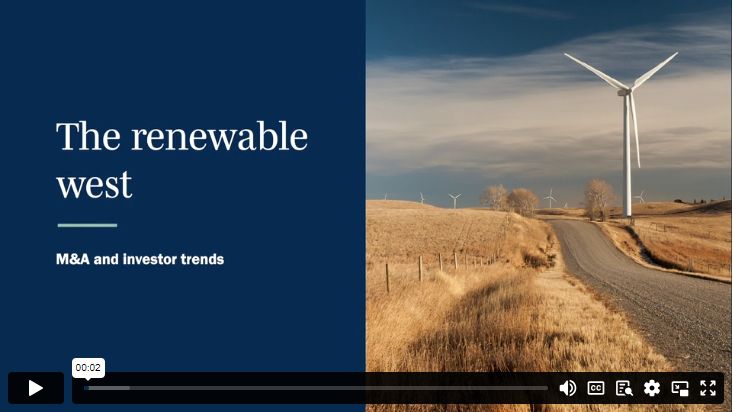- within Insolvency/Bankruptcy/Re-Structuring topic(s)
- with Senior Company Executives, HR and Finance and Tax Executives
- with readers working within the Banking & Credit and Healthcare industries
Video transcript
Amy Maginley (00:05): Alberta has far outpaced the rest of Canada in developing renewable energy capacity in recent years, with M&A activity growing in lockstep with the province's increasing wind and solar capacity. By the end of 2023, renewable energy deals brought in over $6 billion of capital investment into Canada, with a large portion of this coming out of Alberta. Many believe that the province's immense potential for renewable development will become an essential element of Alberta's energy economy in years to come.
Peter Danner (00:35): On top of that, there are a host of other factors like Alberta's business-friendly environment, abundant solar and wind resources, and deregulated electricity market that present a real opportunity for investors. So, Amy, what are some of the trends that investors should be paying attention to as renewables continue to make waves in Western Canada?
Amy Maginley (00:54): Well, investors are paying attention to a number of ongoing regulatory initiatives. These include the government's recent response to the Alberta Utilities Commission inquiry into how renewable energy generation capacity should be developed in the province. The Alberta Electric System Operator's evaluation of the existing market structure, and the provincial government's opposition to the federal government's proposed Clean Electricity Regulations. However, Alberta is a province that has a long history of supporting energy development in all its forms, and we expect that to continue to be the case going forward. Once the noise around these regulatory initiatives has died down.
Peter Danner (01:30): But even during this period of regulatory uncertainty, we've continued to see investment flow into Alberta. There's ongoing interest from both developers and financial players who see the province is an attractive place to do business because of its fundamentals. In particular, we've seen a number of the large European developers acquiring portfolios of assets from local companies in order to enter the market.
Amy Maginley (01:50): That's right. There's also a number of private equity pension funds, Japanese trading houses and other financial players who are looking at renewable energy investment in the region. Alberta is the top emitter of greenhouse gas emissions in Canada, however, this provides a significant opportunity for capital providers to finance all of the necessary infrastructure required in order for the province and industry to meet their carbon reduction goals.
Peter, when you think about your work in renewables, what are some of the themes that stand out to you?
Peter Danner (02:19): Financial investors have sought to deploy different strategies depending on their goals, including financing one-off projects so that they can explore the market before making a larger investment. We have also seen players that already plan to deploy larger amounts of capital first seek to establish an investment platform, most often by acquiring or partnering with a local developer who already has a pipeline of existing projects.
These platform transactions tend to be a little more complex, with a focus of negotiations around how you compensate developers for early-stage pipeline projects while properly incentivizing future growth. So, Amy, one question investors might have is where does this leave Alberta's oil and gas industry?
Amy Maginley (03:00): Well, the oil and gas industry hasn't invested in renewable energy to the same extent as their European counterparts. However, they have focused their efforts on carbon reduction initiatives such as carbon capture and storage. This has created an opportunity for renewable energy developers to partner with Alberta's large industrial base as off takers under physical or virtual power purchase agreements in order to support their project financing. In addition, this has contributed to the robust and diverse energy mix as demand for energy grows.
Peter Danner (03:30): Those are really just a few of the things we're seeing out in the market right now. It's an exciting area to watch as Alberta continues to develop its renewable energy generation, and turn out innovations in the carbon reduction space. We hope you join us for the other videos in this series, where our colleagues take a deeper look at some of the issues mentioned here.
With a wealth of natural resources and a business-friendly environment, Western Canada remains an attractive destination for renewable energy investment. Against the backdrop of energy transition, investors continue to allocate more capital to renewables, adding to the diversity of Canada's energy mix.
In this video, Peter Danner and Amy Maginley discuss:
- Investment potential in Alberta
- Investor responses to regulatory developments
- Investor financing strategies in this space
Click here to see more in this series.
The content of this article is intended to provide a general guide to the subject matter. Specialist advice should be sought about your specific circumstances.



